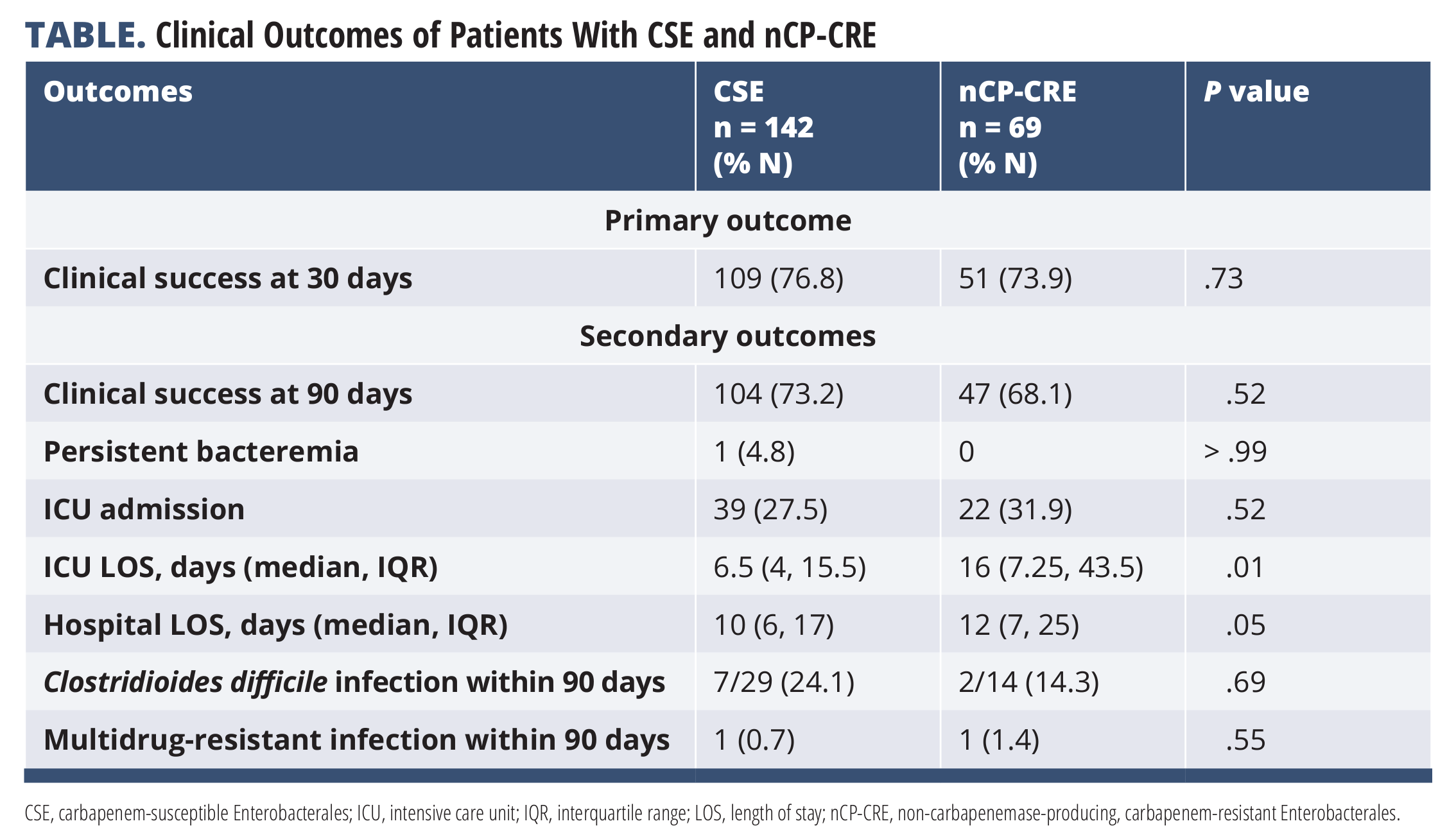CREating New Strategies for the Treatment of Resistant Gram-Negative Infections
This was the first study to compare clinical outcomes in carbapenemase-producing (CP-CRE) and non–carbapenemase-producing (nCP-CRE) infections.
Due to its high rates of morbidity and mortality, carbapenem-resistant Enterobacterales (CRE) is considered an urgent public health threat by the Centers for Disease Control and Prevention.1,2
CRE can be either carbapenemase-producing (CP-CRE) or a non–carbapenemase-producing (nCP-CRE), like the upregulation of beta lactamases mediated by a chromosomal mutation in a porin gene.3 Some studies suggest that because of its greater virulence, CP-CRE may be associated with poorer outcomes than nCP-CRE.4
Although IDSA guidelines include recommendations for CRE, they focus on CP-CRE. When carbapenemase test results are negative, the guidance is to treat ertapenem- resistant, meropenem-susceptible infections with extended-infusion meropenem. In cases of CRE that is resistant to ertapenem and meropenem, newer agents like ceftazidime/ avibactam, meropenem/vaborbactam, or imipenem/cilastatin/relebactam can be used.5
In general, limited clinical data exists on treatment options for nCP-CRE. To address this gap, Debnath and colleagues performed a retrospective, multicenter, observational study in patients 18 years and older who were hospitalized between January 1, 2018, and December 31, 2020, with an Enterobacterales infection from any source and who received more than 48 hours of antibiotics. Patients were excluded if they had inadequate source control, CP-CRE infections, ertapenem- intermediate isolates, CRE infections for which carbapenemase testing had not been performed, surveillance cultures or colonization, or had progressed to hospice or palliative care within 48 hours of therapy.
Patients with CSE and nCP-CRE were compared. The primary end point was composite of clinical success at 30 days. Thirty-day survival, lack of recurrent 90-day infection, and clinical cure at end of therapy factored into the composite. Secondary end points were a composite of clinical success at 90 days, persistent bacteremia, ICU admission within 30 days, hospital and ICU length of stay, rate of Clostridioides difficile infection within 90 days, and rate of multidrug-resistant infection within 90 days.6
In a 2:1 randomization, 211 patients were included in the final analysis: 143 (67%) in the CSE group and 69 (33%) in the nCP-CRE group. Prior carbapenem exposure was more common in the nCP-CRE group (4% CSE vs 15% nCP-CRE; P = .01). Most patients had a urinary source of infection (65% CSE vs 51% nCP-CRE, P = .05). The most common infectious organism was Escherichia coli in the CSE group (57%) and Enterobacter cloacae in the nCP-CRE group (49%). In the nCP-CRE group, 69% of isolates were meropenem-susceptible.
The most common empiric choice was ceftriaxone (40%) in CSE group and piperacillin/tazobactam in the nCP-CRE group (33%). For definitive therapy, ceftriaxone was more commonly used in the CSE group (26% CSE vs 6% nCP-CRE, P < .01), whereas patients with nCP-CRE infection received higher rates of ciprofloxacin (18% CSE vs 35% nCP-CRE, P < .01) and meropenem (1% CSE vs 12% nCP-CRE, P = .01).
Most nCP-CRE infections were treated with carbapenem-sparing monotherapy. Resistance to the empiric antibiotic was more likely in patients with nCP-CRE (6% CSE vs nCP-CRE 57%, P < .01), and resistance to piperacillin/tazobactam and ceftriaxone was more common in the nCP-CRE group (38% vs 28%).6

Clinical success at 30 days was similar between the groups (77% CSE vs 74% nCP-CRE, P = .73) and only 1 statistically significant difference was noted in secondary outcomes (TABLE): the nCP-CRE group had a longer ICU stay than the CRE group (16 vs 6.5 days, P = .01).
Study limitations included retrospective design and high rates of urinary tract infections, which could have led to treatment of asymptomatic bacteriuria. Even with exclusion of colonization, this may have led to inappropriate treatment, thereby decreasing the study’s internal validity.
This is the first study comparing clinical outcomes in nCP-CRE and CSE infections. There were no differences in 30-day survival between groups, even though more patients in the nCP-CRE group received inappropriate empiric therapy.
Although use of newer agents like ceftazidime/avibactam and meropenem/ vaborbactam was minimal, the study suggests that these therapies may not be needed in nCP-CRE infections.6 Furthermore, carbapenems may likewise not be required, particularly for urinary sources of nCP-CRE. Given the limited data on nCP-CRE treatment, additional studies assessing clinical outcomes in this setting would help optimize treatment and further stewardship efforts.6
References
- Carbapenem-resistant Enterobacterales (CRE). Centers for Disease Control and Prevention. Accessed July 14, 2021. https://www.cdc.gov/hai/organisms/cre/index.html
- Antibiotic resistance threats in the United States, 2019. Centers for Disease Control and Prevention. https:// www.cdc.gov/drugresistance/pdf/threats-report/2019-ar- threats-report-508.pdf.
- Zou H, Xiong SJ, Lin QX, Wu ML, Niu SQ, Huang SF. CP-CRE/non-CP-CRE stratification and CRE resistance mechanism determination help in better managing CRE bacteremia using ceftazidime-avibactam and aztreonam-avibactam. Infect Drug Resist. 2019;12:3017-3027. doi:10.2147/IDR.S219635
- Tamma PD, Goodman KE, Harris AD, et al. Comparing the outcomes of patients with carbapenemase-producing and non-carbapenemase-producing carbapenem-resistant Enterobacteriaceae bacteremia. Clin Infect Dis. 2017;64(3):257-264. doi: 10.1093/cid/ciw741
- Tamma PD, Aitken SL, Bonomo RA, Mathers AJ, van Duin D, Clancy CJ. IDSA Guidance on the treatment of antimicrobial-resistant gram-negative bacterial infections: version 1.0. Infectious Diseases Society of America. https://www.idsociety.org/practice-guideline/amr-guidance/
- Debnath A, Pillinger KE, Martin AJ, Dobrzynski D, Cameron A, Shulder S. Clinical outcomes and treatment strategies in patients with non-carbapenemase-producing carbapenem-resistant versus carbapenem-susceptible enterobacterales infections. Ann Pharmacother. 2022:10600280221132019. doi:10.1177/10600280221132019

